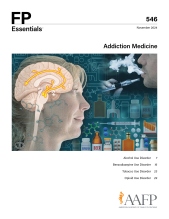
This clinical content conforms to AAFP criteria for CME.
Practice guidelines consistently encourage short-term use of benzodiazepines for the management of common medical conditions. However, these medications are often prescribed long-term for unclear or variable indications. These prescribing patterns may be attributed to perceived low risk and low rate of benzodiazepine use disorders (0.2% of US adults). Compared with other addictive substances, benzodiazepines may have less overall risk and fewer adverse outcomes. Benzodiazepines have limited accessibility compared with alcohol and tobacco. When used alone, benzodiazepines have less risk of lethal overdose than when they are coprescribed with opioids. Although benzodiazepine use for pain management is declining, this use often co-occurs with opioid analgesics, which is associated with greater risk of adverse events. Physician prescribing patterns have a tremendous impact on benzodiazepine use disorder and misuse. Primary care physicians play a vital role in preventing these conditions and in the management of benzodiazepine withdrawal. Effective management of benzodiazepine use disorder and misuse relies on targeted screening and intervention. Concomitant conditions associated with benzodiazepine misuse (eg, chronic pain, anxiety, insomnia) should be adequately addressed in treatment planning. Due to questionable effectiveness of alternative medications in managing benzodiazepine withdrawal, intervention should entail a gradual dose reduction that is facilitated by patient-centered tapering schedules.
Subscribe
From $350- Immediate, unlimited access to FP Essentials content
- 60 CME credits/year
- AAFP app access
- Print delivery available
Edition Access
$44- Immediate, unlimited access to this edition's content
- 5 CME credits
- AAFP app access
- Print delivery available
